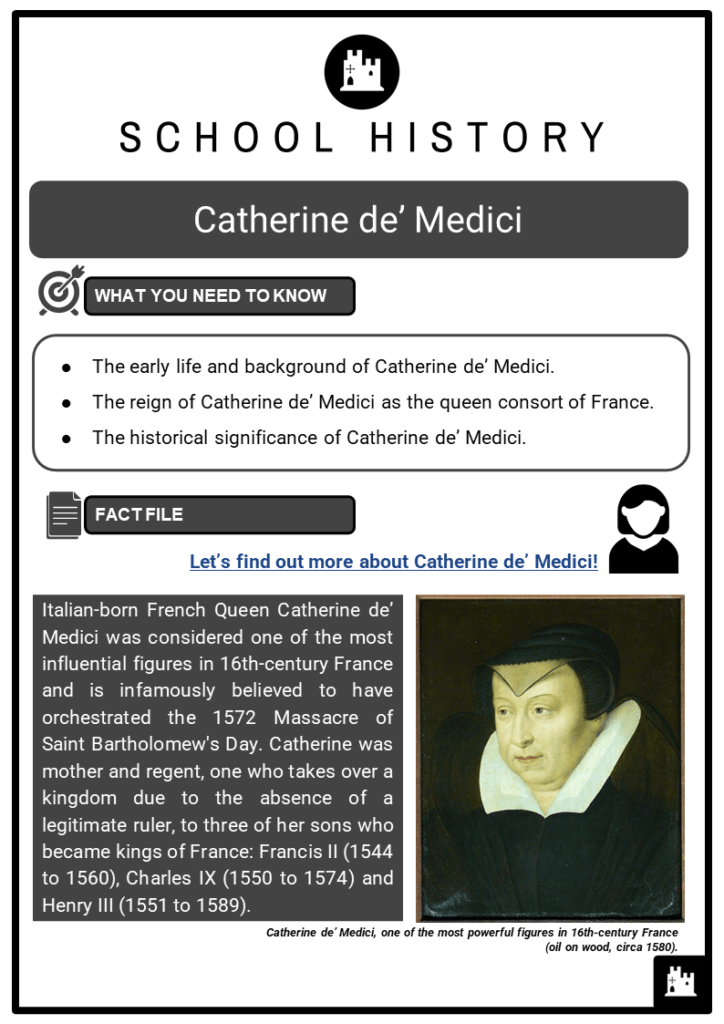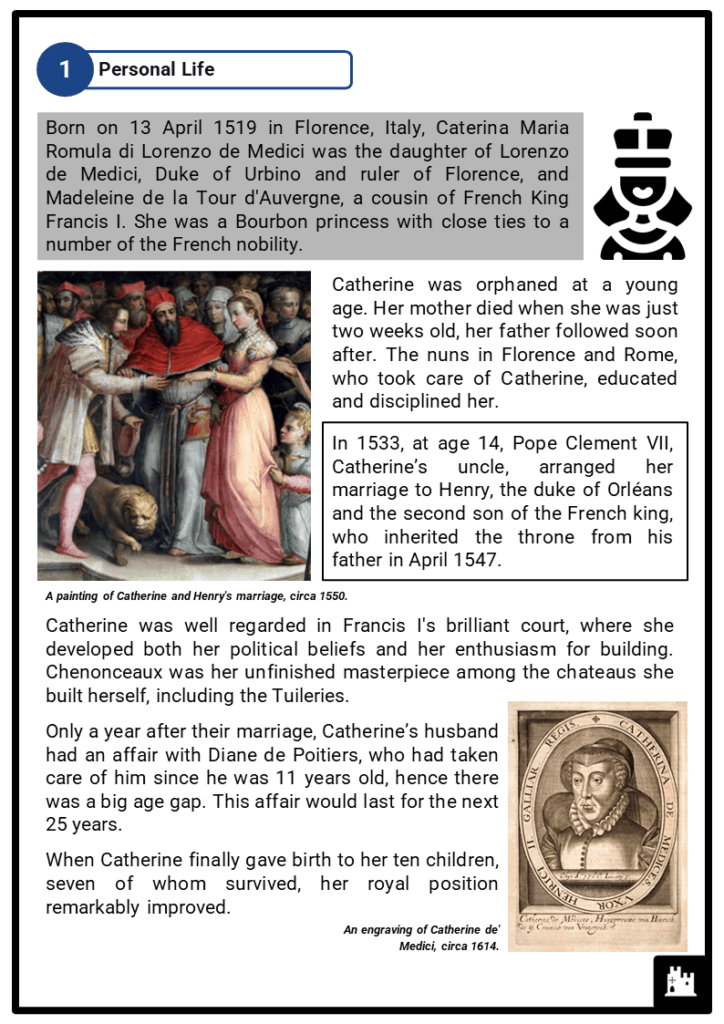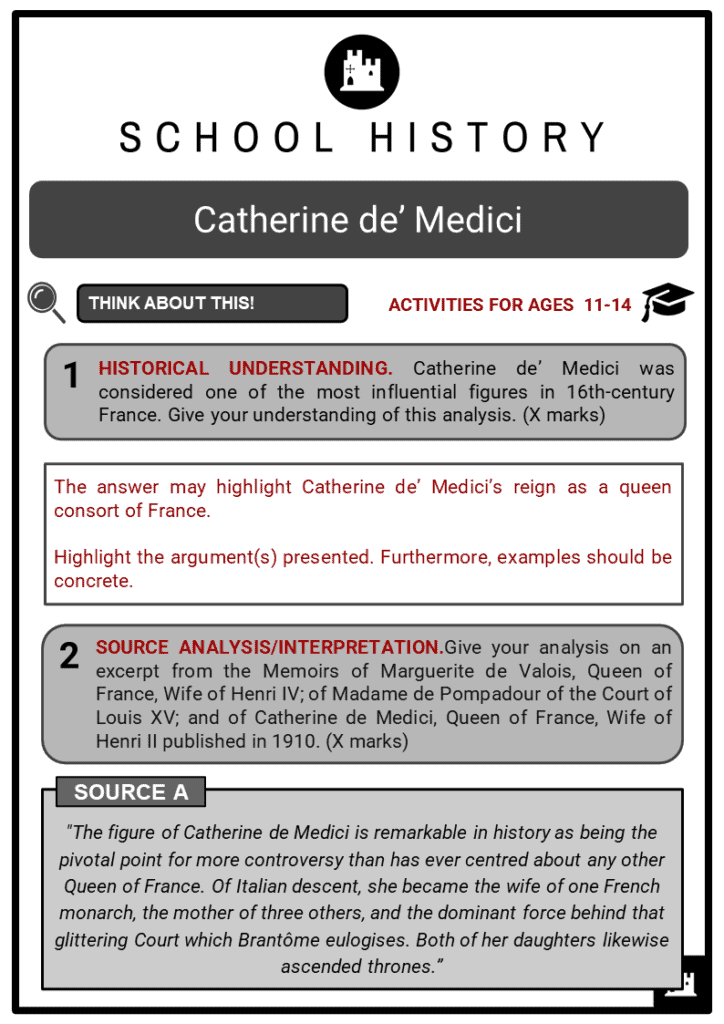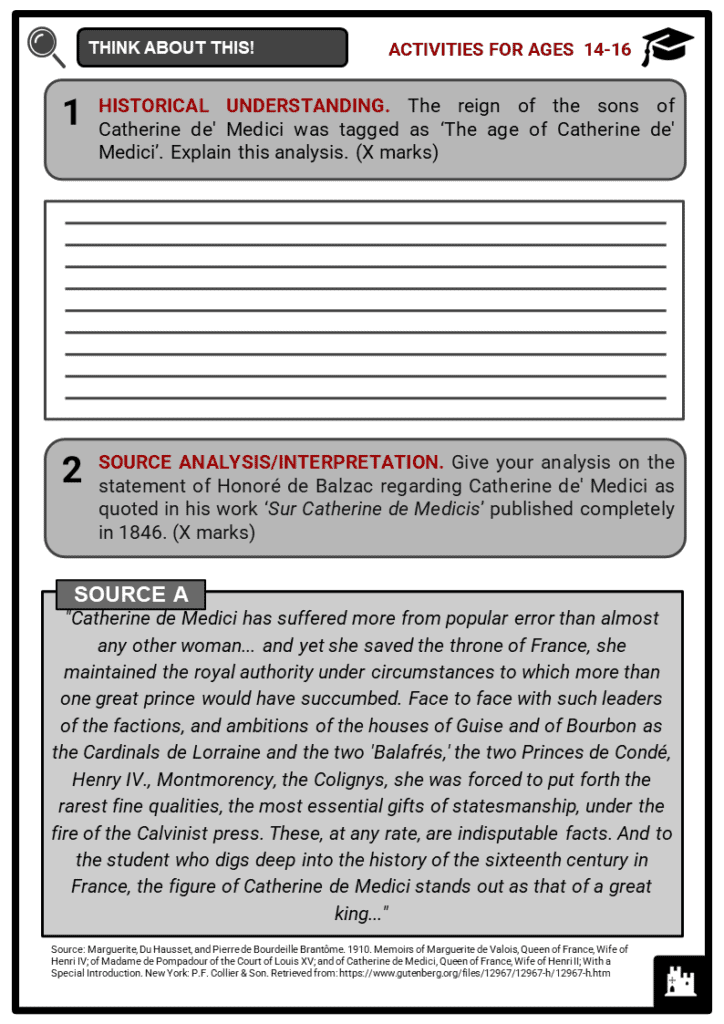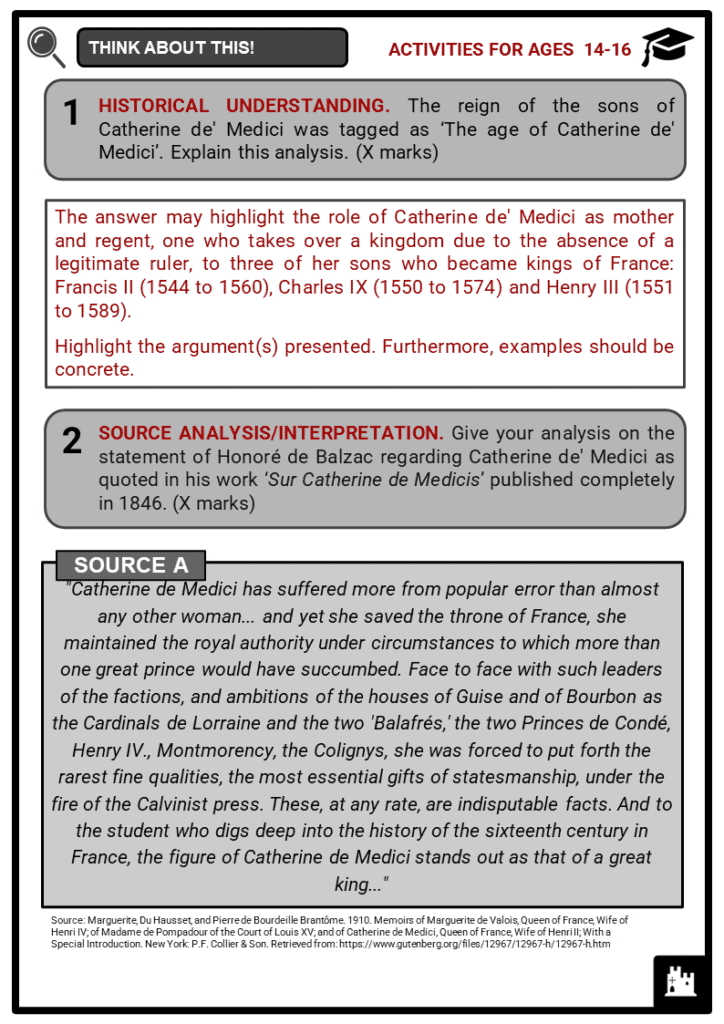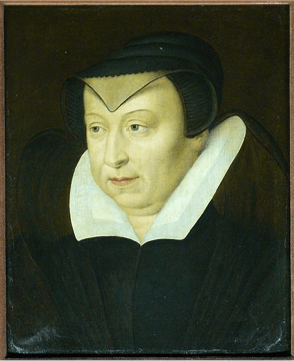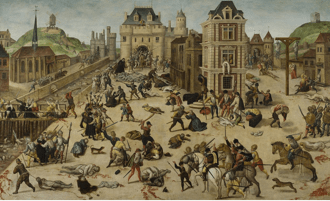Download Catherine de’ Medici Worksheets
Do you want to save dozens of hours in time? Get your evenings and weekends back? Be able to teach Catherine de’ Medici to your students?
Our worksheet bundle includes a fact file and printable worksheets and student activities. Perfect for both the classroom and homeschooling!
Table of Contents
Add a header to begin generating the table of contents
Summary
- The early life and background of Catherine de’ Medici.
- The reign of Catherine de’ Medici as the queen consort of France.
- The historical significance of Catherine de’ Medici.
Key Facts And Information
Let’s find out more about Catherine de’ Medici!
- Italian-born French Queen Catherine de’ Medici was considered one of the most influential figures in 16th-century France and is infamously believed to have orchestrated the 1572 Massacre of Saint Bartholomew's Day. Catherine was mother and regent, one who takes over a kingdom due to the absence of a legitimate ruler, to three of her sons who became kings of France: Francis II (1544 to 1560), Charles IX (1550 to 1574) and Henry III (1551 to 1589).
Personal Life
- Born on 13 April 1519 in Florence, Italy, Caterina Maria Romula di Lorenzo de Medici was the daughter of Lorenzo de Medici, Duke of Urbino and ruler of Florence, and Madeleine de la Tour d'Auvergne, a cousin of French King Francis I. She was a Bourbon princess with close ties to a number of the French nobility.
- Catherine was orphaned at a young age. Her mother died when she was just two weeks old, her father followed soon after. The nuns in Florence and Rome, who took care of Catherine, educated and disciplined her.
- In 1533, at age 14, Pope Clement VII, Catherine’s uncle, arranged her marriage to Henry, the duke of Orléans and the second son of the French king, who inherited the throne from his father in April 1547.
- Catherine was well regarded in Francis I's brilliant court, where she developed both her political beliefs and her enthusiasm for building. Chenonceaux was her unfinished masterpiece among the chateaus she built herself, including the Tuileries.
- Only a year after their marriage, Catherine’s husband had an affair with Diane de Poitiers, who had taken care of him since he was 11 years old, hence there was a big age gap. This affair would last for the next 25 years.
- When Catherine finally gave birth to her ten children, seven of whom survived, her royal position remarkably improved.
- Although she lived privately as she focused her attention on her children’s education, Catherine was named regent in 1552 due to Henry’s absence at the siege of Metz during the Italian War.
Political Conflicts
- When the duke of Orleans succeeded to the throne as Henry II, his rule would only be short-lived, as he suffered a jousting accident in July 1559, ultimately causing his death. This passing of her husband marked the years of political crises that Catherine would go through.
- Consequently, Catherine’s eldest son Francis II was hailed as king. During this period, power was primarily held by the Guise family.
- Catherine’s influence became apparent in March 1560 during the Amboise Conspiracy when the Huguenot gentry petitioned against the Guisard persecution in the King's name.
- This turbulent lobbying, which resulted in the Edict of Amboise, was quickly followed by the Edict of Romorantin in May of that year, essentially distinguishing heresy from sedition, thus separating faith from allegiance.
- The untimely death of Francis II on 5 December 1560 would lead to the succession of Catherine's second son Charles IX to the throne, at age 10, whose reign was ultimately dominated by her mother as the acting regent.
- From 1560 to 1570, Catherine’s political career faced more conflicts as she underwent three civil wars, also known as the French Wars of Religion, and struggled against the Catholic extremists for the French crown's independence, peace and limited toleration.
- With the help of the influential chancellor Michel de L'Hospital in 1561, Catherine began to solve the religious conflict by appeasing the heads of both religious factions.
- Between September and November 1561, the Colloquy of Poissy was convened with the goal of religious reconciliation. However, it rendered no success.
- In 1562, Catherine passed the Edict of January, her most evident achievement, which provided the Calvinists with licensed coexistence with other religious factions.
- The edict was followed by the Protestants, while the Catholics opposed it. The Catholic resistance eventually resulted in the first civil war within the same year.
- The first civil war came to an end in March 1563 through Catherine’s Edict of Amboise, a reduced version of the Edict of January.
- In June 1565, via a meeting at Bayonne, Catherine sought to strengthen the crown’s relations with Spain and proposed the marriage of her son Charles to Elizabeth of Austria.
- Due to a conflict with the statesman of the Guise family, cardinal Lorraine, the second civil war broke out that lasted from September 1567 to March 1568. Catherine ended the political crisis through the Amboise-like Peace of Longjumeau.
- However, the agreement was revoked in August 1568, resulting in the third civil war. The signing of the Treaty of Saint-Germain in August 1570 temporarily ended the decade of conflict.
- In an attempt to restore peace, Catherine arranged the marriage of her daughter Marguerite and the Protestant King Henry of Navarre in 1572. But during the ceremonies in Paris, Coligny, the Huguenot leader, along with hundreds of other Protestants present at the wedding, was assassinated.
- This horrendous incident, which was largely attributed to Catherine, eventually became known as the Saint Bartholomew’s Day Massacre.
Final Years
- Following the Massacre of Saint Bartholomew’s Day, Catherine became more worried about the succession of Anjou to the Polish crown than the possibility of a fourth civil war.
- When Charles IX died in 1574, Catherine’s favourite son Henry was proclaimed king of France a year later. Henry III got married, but he had no children.
- Fearing another uprising from the Guise family, Catherine tried to convince Henry to settle the conflict. Unfortunately, Catherine learned that Henry’s guards killed Guise.
- Henry III was murdered within the same year, resulting in the succession of the Huguenot prince Henry of Navarre to the throne.
- On 5 January 1589, Catherine died. She was buried close to her husband in the Parisian Church of Saint Denis.
Image sources:
- https://commons.wikimedia.org/wiki/File:Catherine_de_M%C3%A9dicis_Louvre.jpg
- https://upload.wikimedia.org/wikipedia/commons/2/21/Henri_%26_Catherine.jpg
- https://commons.wikimedia.org/wiki/File:La_masacre_de_San_Bartolomé,_por_François_Dubois.jpg

